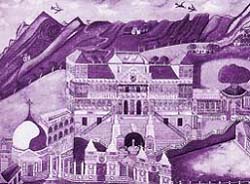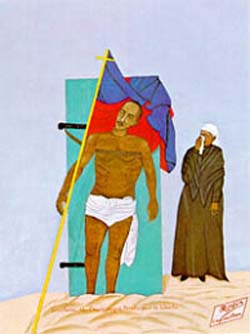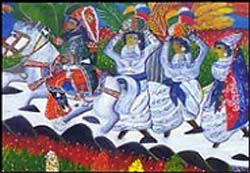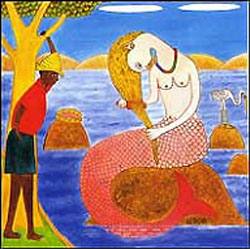PREÁMBULO
Haití
cuenta con tantos y connotados artistas plásticos, que honrarlos
individualmente no estaríamos haciendo justicia al talento de la isla mágica,
por lo que Pinceladas a manera de regalo de navidad les ofrece esta
historia del arte haitiano en espera de contribuir a su mayor
enriquecimiento.
A History of Haitian Art
Without
a doubt, Haitian Art, especially painting and sculpture, is among the most
appreciated in the world. It continues to receive critical acclaim while
at the same time enjoying some measure of commercial success. Yet,
that success comes with a history of controversy, as Haitian artists,
local and western critics have dueled over what form of artistic
expression is more authentic and therefore worthy of consideration as
characteristic haitian art.
 The
Beginnings The
Beginnings
While
most books on Haitian Arts conveniently begin their history of Haitian Art
with the Centre D'Art in 1944, there is however clear evidence of artistic
activity dating back to the Pre-Columbian era. The Tainos would make
dolls, drawings, signs (maybe the ancestors of the vèvè in vaudou) that
represented their deities.Archeologists also found sculptures and pots of
many kinds that were wonderfully crafted. All this indicates a vibrant
artistic life existing as part of everyday life among the Taino.
There
exists a record of a former slave called Luc, from Leogane, who, during
french colonial times earned a reputation as a painter. In the days after
Independence, both Henri Christophe and Alexandre Pétion were patrons of
the arts.They regularly entertained European artists, and also founded
some art schools at the time. In Christophe's court, foreign and local
artists alike found ample commission work. The main themes were to the
glory of the Revolution or the Royal family itself. One of those artists
was Numa Desroches (1802-1880) who produced one of the most intriguing
paintings of that period. It is a view of Palais Sans Souci with a spatial
distribution that reminds one of the naïve paintings of the 20th Century.
In the 1840s, the Emperor Soulouque founded an Imperial Academy of the
Arts.
Further
evidence of artistic activity comes from a photograph dated from c. 1900
that shows a shack adorned with religious paintings. Again the style of
the paintings is close to the Primitive Art ("Art naïf")
that would become popular from the 1940s. Both paintings show that style
of painting is a long tradition in Haiti instead of being the result of
the work of any Art School.
In
the early 20th Century a giant emerges from the northern town of
Cap-Haitien. He was Philomé Obin (b 1892-?) arguably among the top 5
Haitain painters ever. Obin was a self-taught painter whose main themes
were scenes of every day life in Cap-Haitien and historic scenes of the
Haitian Revolution. In many ways, his work is representative of the spirit
of the 20s and 30s when the global negritude movement would see a local
manifestation in Haiti with the Indigenist movement.
 Indigenism
and Modernism Indigenism
and Modernism
Indigenism meant
returning to the African roots and finding new aesthetic values and a
natural cultural identity. One of the first painters to respond to the
call of the indigenist movement was Petion Savain. His style was realist
and simple. Of the artists who were to follow his style, we could note
Georges Ramponneau. Cuban and Caribbean influence were to give rise to the
Modernist movement. Modernism was most mostly embraced by the elite.
Modernist painters of note included Luce Turnier (1924-1994), Lucien Price
(1915-1963) etc. They tried to adapt modern artistic theories to the local
environment in the manner of a Wilfredo Lam, the Cuban master. Clearly
there is a strong record of artistic activity predating 1940. Haitian
artists did not learn how to paint out of the blue, or through the
intervention of some foreigners, like some books would, but rather
displayed an influence by traditions that go way back and a have a good
body of work to show for it.
 The
Naive Art movement and the Centre d'Art The
Naive Art movement and the Centre d'Art
In the 1940s, Dewitt
Peters, an American school teacher arrived in Haiti. Almost immediately he
was striken by the raw artistic talent displayed by many untrained and in
many cases uneducated painters he would encounter. Those were people who
never went to Art School, workers of all trades, who would come home and
produce marvels of ingenous art work. In 1944, He founded the Centre d'Art
in Port-au-Prince . The Centre d'Art became the champion of the art form
that would be known as "Naïve Art", "peinture naïve"
or better called "intuitive art" (1). Intuitive painting is
characterized by vivid, raw colors, a spatial composition and use of
proportions that did not abide by any of the laws of modern aesthetics,
but rather revealed spontaneity, freedom of expression and freshness. That
art form would attain notoriety on the world scale, especially with the
arrival of co-director Selden Rodman. Selden Rodman rejected modernism,
the leading art movement of the time, as being too post-war, too vanguard
and therefore too socially inclined. Contrarily to what many manuals
wrote, though, neither the Centre D'Art nor Dewitt Peters invented Naïve
Art. Nevertheless, they are credited for their efforts in having brought
it to the attention of the Western World. The primitives of the first
generation received worldwide acclaim. Critics and collectors received
that movement as "authentic" and "unspoiled". The main
heroes of that movement were otherwise common, non artistically trained
folk who had great talent. They were André Pierre, Hector Hippolyte
(1894-1948), Castera Bazile (1923-66), Wilson Bigaud (b. 1931) and Rigaud
Benoit (b. 1911). Vaudou was prominently featured in the works of those
artists. Andre Pierre and Hippolyte themselves were vaudou priests. The
cornerstone piece of the Primitive Art School has to be the mural project
of the Cathedral of Sainte Trinité (Holy Trinity). For that mural, Obin,
Benoit, Bazile and Bigaud placed traditional religious motifs like the
Ascension of Christ in a very Haitian context. Characters were painted
with black faces, while drums and sacrificial animals were featured in a
few of the paintings. The Primitive Movement was accompanied by great
controversy. Many other Haitian artists, the intelligentsia and the elite
alike resented the seal of authenticity attached to Naïve Art. Why would
only unschooled artists be recognized as authentic Haitian artists? Even
if for the wrong reasons, the generally reactionary haitian elite of the
time had a point. In earnest what gives Western critics the right to
decide what represents true Haitian Art? What gives the Centre d'Art the
mandate to act as arbitrator, championning one movement versus others?
Haitian painters to this day have to deal with the preconceived notion
that Haitian Art is supposed to ressemble work from that era for it to be
authentic. Collectors attach high value to the works of the masters from
that era while eschewing the work of even accomplished artists displaying
more contemporaneous trends as being unrepresentative of Haitian Art as
critics or they conceive of it. Well, for better or for worse, Intuitive
Art and its champion, the Centre D'Art, became a driving force behind the
Haitian Art industry as a whole by bringing worldwide attention towards
the small nation. For one, the Centre D'Art gave a chance to painters who
otherwise would never be noticed by the conservative art establishment of
the time. It allowed vaudou artists like Hector Hippolyte and Andre Pierre
to express themselves, and made religious art more acceptable. It provided
support and a market for generations of painters and made international
celebrities out of many. Intuitive Art became very prized by tourists who
kept alive a whole industry, even when the quality of the art work over
the years, especially what is found on the streets, became quite
questionable. Intuitive Art from the 50s and on became a cash crop that
even the elite in turn cultivated by buying the best of the genre for
display in posh galleries. Therein lies the great irony. With Haitian Art,
success is often a double-edge sword. Whenever an art form gets some kind
of critical recognition, foreign demand and foreign backing would
automatically increase. In turn, artists who many times worked for
galleries would get specific demands and feedback:"Do more market
scenes", or "landscapes are very hot now". That sort of
feedback ultimately becomes detrimental because it hinders the natural
disposition of the artist and forces him/her to slant energies towards
popular themes and styles. They would be compelled to mass-produce art
work in line with what is popular, instead of what they were inspired to
do. Before long, many copycats and wannabes would emerge and ultimately,
the whole movement would turn into commercialism, with decreasing
freshness, originality and hence quality of production.
 Aftermath
of the Naive Movement Aftermath
of the Naive Movement
There were many offshoots
to the Naïve movement. Philomé Obin would create the School of
Cap-Haitien that included artists such as Sénèque Obin (1893-1977), his
younger brother. Second generation intuitive painters include Gerard
Valcin (1925-88), Wilmino Domond, Seymour Bottex, Gabriel Alix, Gesner
Armand and Prefete Duffaut (b. 1923). The second generation is
characterized by a certain departure from the style of the orignal masters
of the 40s. Many of those artists like Armand would through their travels
learn other techniques and would use them to enrich and solidify their
original style. This work by Bottex at the left uses vivid colors
reminding one of the originals but his use of the curve, the flatness of
his colors, the simplicity of the themes is indicative of not just his
style, but is also characteristic of the evolution of the pimitive
movement. Another example is Prefete Duffaut is especially famous for his
mountainous landscapes where Heaven meets Earth and the laws of Gravity
are nonexistent. Duffaut would later create the School of Jacmel in the
country's south east. Other primitives of the second generation are famous
for their depictions of jungles with lions and tigers in a local context,
or oversized fruits. The Poto Mitan (pole in the center of a hounfor, a
vaudou temple) School of 1968 shows renewed interest in Vaudou and
Pre-Hispanic themes. It featured Tiga (Jean-Claude Garoute b. 1935) Maud
Robart and Patrick Vilaire (b. 1942). Tiga and Robart would be at the
origin of what Andre Malraux called the most striking experiment of
magical painting he had ever seen. That was the Saint Soleil experiment.
In the early 70s. Tiga and robart, already famous painters who rejected
the prevalent primitive movement wanted to createa community of artists
whose inspiration stemmed from pure unadulterated haitian sources. They
bought a property in the mountains where they distributed art materials to
a group of peasants who have never painted to see what would come out. The
results were spectacular. The major artists produced by that experiment
include Louisiane St Fleurant, Prospere Pierre Louis (1947-96),
Antilhomme, Levoy Exil (b. 1944) and later on, Stevenson Magloire, son of
Louisiane. Andre Malraux, the famous french writer came to visit the
workshop and was amazed at the results. He devoted a whole chapter of his
last book l'Intemporal to Saint Soleil. Alas, just as before success
became detrimental to Saint Soleil. part-time artists became full-time
astists and soon, as commercialism again ensued, the school disbanded.
There were other counteractions to Naïve Art. One of them, Modernism
wanted to adapt more established painting styles to the local settings. In
the 50s, many artists like Lucien Price and Dieudonné Cédor broke away
from the Centre D'Art and founded the "Foyer Des Arts
Plastiques" another academy of painting. However, the movement lacked
focus and soon waned. One of the few commercially successful reactions to
Intuitive Art was the School of Beauty, with Bernard Sejourne (1947-1994),
Jean Rene Jerome (1942-91), Philippe Dodard, and Emilcar Similien. Their
style was of a dreamy surrealism, where the individual was featured
instead of the group; where personal feelings and thoughts received focus
instead of the national consciousness. The School of beauty soon lapsed
intorich ornamental luxury and commercialism as soon as success came to
its members.
 The Others
The Others
A few painters are worth
mentionning although they do not seem to fit any category. We have Bernard
Wah (1939-1982), seated somewhat at the other extreme of the School of
Beauty, although a key member, who displayed a quasi-mechanical approach
to his characters approaching the macabre or the fantastic. Another is
Lyonel Laurenceau, master of the knife painting technique whose portraits
of simple folk were popular from the late 70s to today. Herve Thelemaque
achieved notoriety in France, while Claude Dambreville excelled with his
high contrast, flat color scenes of women at the market.Let us mention a
few masters of iron work: Georges Liautaud who started out by making
funeral crosses in the town of Croix des Bouquets, Serge Jolimeau, who
achieved worldwide notoriety, John Sylvestre, and the Louis Juste brothers
all from Croix des Bouquets. Sculptors of note include Albert Mangones who
produced the famous "Marron Inconnu" statue in Port-au-Prince.
Let us also salute a great artist of haitian descent whose fame in the 80s
was as brilliant as it was short lived: Jean Michel Basquiat, a
quintessential modern artist whose work was part Andy Warhol, part
Brooklyn ghetto. Finally, what of the present? The artistic production of
Haitians has never been more alive with many branches existing now, with
so many Haitians living in the diaspora. The young artists show great
promise, while some of the old masters show extra life. But let us end by
mentioning some of the accomplished artists of this generation: Henri
Dubreuil, Ernst Louis Jean, Roosevelt François, Ernst Louizor,
Valmidor... Just to name a few. 1- Calling the brand of Art these
untrained and uninfluenced painters practiced as naive or primitive is
generally considered being pejorative; the term intuitive is the more
correct and more accepted qualifier for the art form.
Fuente: Discoverhaiti
Recopilado por Gabriel Gross
|

 The
Beginnings
The
Beginnings Indigenism
and Modernism
Indigenism
and Modernism The
Naive Art movement and the Centre d'Art
The
Naive Art movement and the Centre d'Art Aftermath
of the Naive Movement
Aftermath
of the Naive Movement The Others
The Others